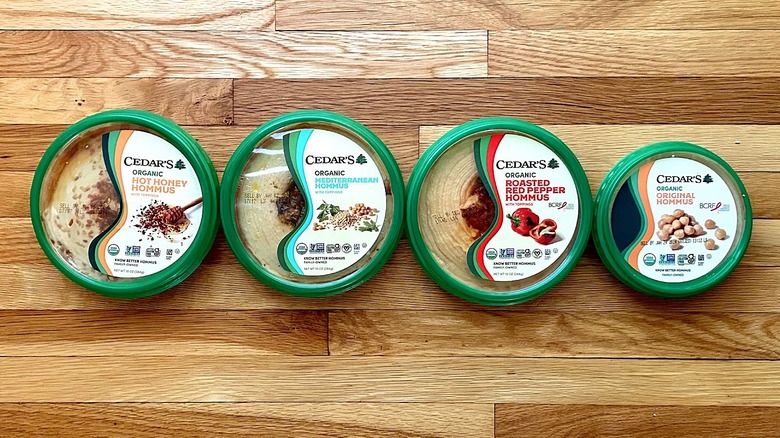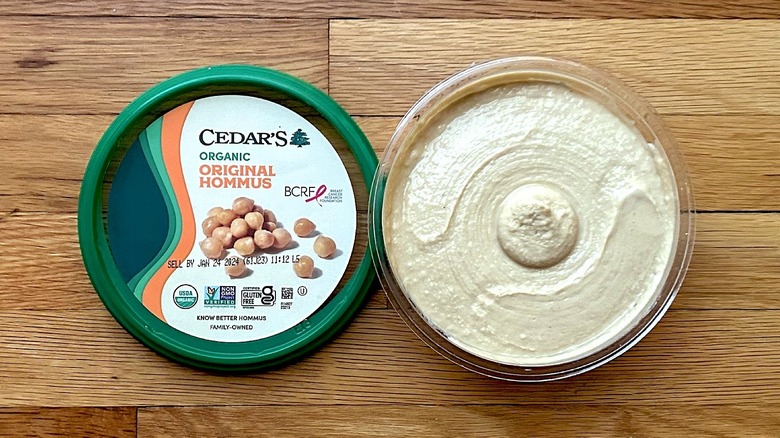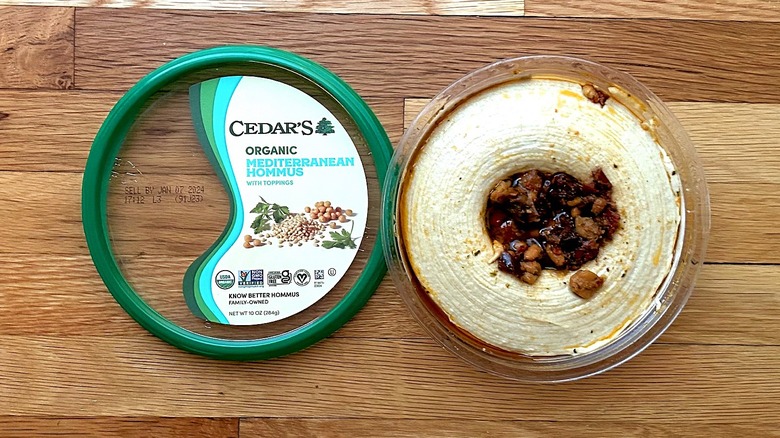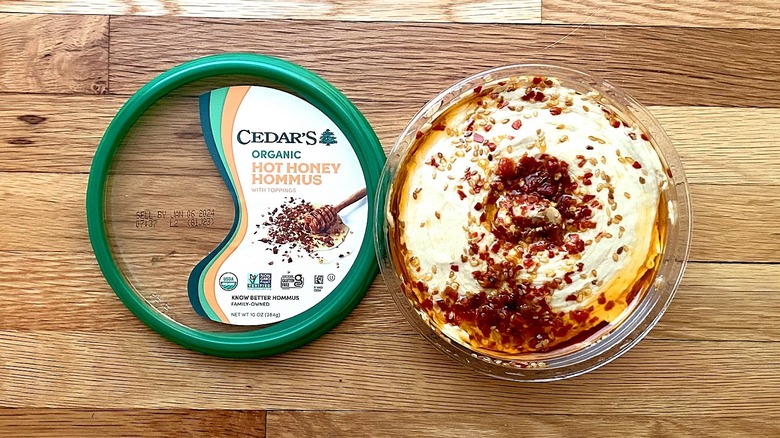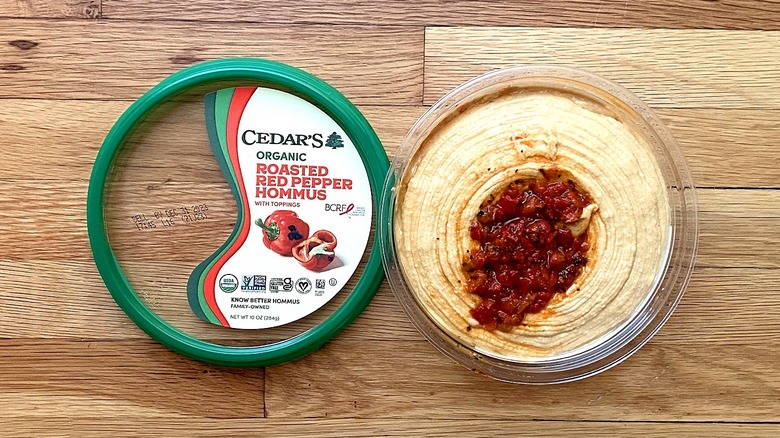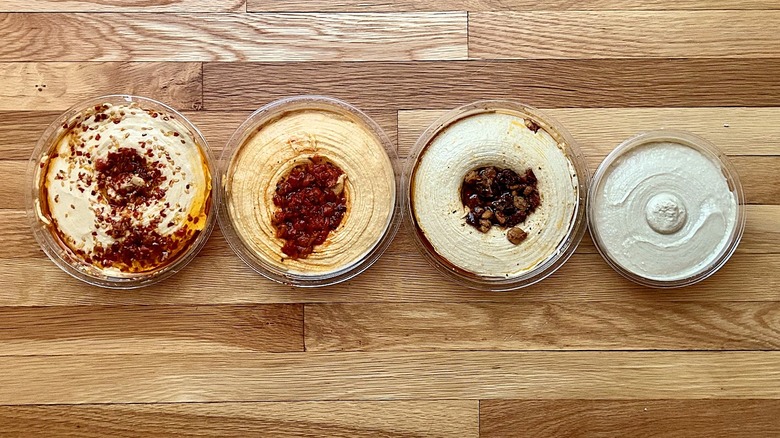We Tried Four Of Cedar's Hommuses And Enjoyed The Simple, Authentic Flavors
Cedar's Mediterranean Foods prides itself on three tenets: A simple recipe, pure ingredients, and honest preparation. Its story began on the Mediterranean seacoast where hommus is spelled with an "O." This is where founder Abe Hanna perfected the recipe for his signature dip. He soon relocated to New England, where Cedar's was established.
While the company has since expanded its repertoire to include a myriad of other dips and Mediterranean gourmet items, its heart still lies with its original baby — hommus. Each batch of Cedar's hommus starts with organic, verified non-GMO, and certified gluten-free ingredients. The chickpeas are soaked and puréed to creamy perfection, combined with generous amounts of tahini paste and authentic Mediterranean spices.
I had the opportunity to sample four of Cedar's organic hommus varieties: Original, Mediterranean, Hot Honey, and Roasted Pepper. As a chef, vegetarian, and self-proclaimed hommus snob who makes and regularly consumes the dip, I evaluated each flavor with a critical eye for aroma, texture, and taste. Read on for the full scoop on what these hommus varieties taste like and where you can find them.
Some recommendations are based on first-hand impressions of promotional materials and products provided by the manufacturer/distributor/etc.
What does the Organic Original Hommus taste like?
From the moment I peeled back the vacuum-sealed cover of Cedar's Organic Original Hommus, the aroma of tahini wafted through the air. This filled me with hope, as one of the primary complaints I have with most commercially produced hummus is that it tends to be overly precious with its use of tahini paste. The texture of this hummus is quite creamy, without an ounce of graininess.
The flavor of this hummus is assertively acid-forward but in a good way. Notes of garlic and cumin are there, but not overly potent. The salt is well-measured, and the tahini is a featured element. Overall, this is a hummus that's well-balanced. Its faithfulness to tradition and simplicity are what make it great.
This hummus blends chickpeas with tahini, oil, sea salt, garlic, citric acid, cumin, and guar gum. Each two-tablespoon serving contains 80 calories, 6 grams of fat, 110 milligrams of sodium, 3 grams of carbohydrates, and 2 grams of protein. This variety is also certified vegan.
What does the Organic Mediterranean Hommus taste like?
To fully appreciate the Organic Mediterranean Hommus, thoroughly stir the toppings into the dip. Doing so took some effort to ensure the ingredients were evenly distributed; if there was one wish I had with some of these flavored hummus varieties, it is that they pre-mix them, although there is some validity to being able to scoop as much or as little of the topping into each serving. For me, though, it would be far more efficient to have the added ingredients already combined.
The aroma of this hummus was distinctly that of pine nuts and parsley. The flavor highlights the acidity of the vinegar, the pine nut creaminess, and the brightness of the herbs. What I would have wanted a touch more of was the roasted pepper. The salinity of this hummus was en pointe. Again, the tahini was suitably prominent. Overall, this was a great hummus.
This variety of Cedar's Hommus features the original recipe with a topping made from whole chickpeas, pine nuts, oil, vinegar, roasted red pepper, and chopped parsley. A two-tablespoon serving has 80 calories, 7 grams of fat, 105 milligrams of sodium, 3 grams of carbohydrates, and 2 grams of fat.
What does the Organic Hot Honey Hommus taste like?
If I had a favorite among the varieties of Cedar's Hommus, the Organic Hot Honey flavor would be it. This was by far the most unique combination and not something I've ever seen before. Combining the topping thoroughly is critical for this hummus, or you can get a disproportionate amount of spicy chilis in a bite. The aroma was predominantly chili-forward and, though the honey is there, it's somewhat less evident than the heat from the chilis. The nutty sesame seeds and tahini paste give this hummus a distinct and bold flavor profile, and the salt is well-measured.
Overall, this is a well-balanced hummus. If I had even had one tiny criticism, it would be that I might have preferred a hint of more honey to temper the spicy chilis. The heat level of this hummus was on the medium side, likely making it an acquired taste for some who may be sensitive to spicy foods. That said, I loved it.
This is yet another iteration of the original hummus, with a topping made from oil, crushed red chili pepper, sesame seeds, honey, and dehydrated red pepper. A two-tablespoon serving has 80 calories, 6 grams of fat, 110 milligrams of sodium, 5 grams of carbohydrates, 2 grams of sugar, and 2 grams of protein.
What does the Organic Roasted Red Pepper Hommus taste like?
Roasted red pepper hummus is generally a go-to in my household, and this one would be no exception to the rule. It's a well-executed iteration with sweet and smoky roasted peppers added to the original hummus recipe and chopped into a bright crimson topping. While the roasted peppers atop the dip need not be stirred into the hummus, I did. I found the texture of this hummus a bit denser than the others but not any more grainy. It was still suitably smooth and had a pleasant mouthfeel. The aroma was distinctly roasted pepper-forward and, like the others, the salt and tahini of this hummus were well balanced.
What I might have enjoyed more of was a hint of heat. The paprika and cumin are present but somewhat overwhelmed by the peppers. Otherwise, there is nothing wrong with this hummus, and I would gladly consume it again and highly recommend it to those who like peppers.
Each two-tablespoon serving of this hummus has 60 calories. It also has 0.5 grams of fat, 110 milligrams of sodium, 4 grams of carbohydrates, 1 gram of sugar, and 1 gram of protein.
Final thoughts
Cedar's Mediterranean Foods can be purchased via most online retailers. They can also be found at grocery stores nationwide, and you can search for a store near you via its website. Prices vary by package size, type, and retailer.
If I were grocery shopping and found Cedar's alongside my typical preferred brand, I would consider purchasing it instead. This is an authentically flavored, high-quality product with numerous unique varieties to sample, particularly in its traditional hommus line.
I would also be interested in sampling one of the many other dips produced by Cedar's, like its tzatziki, labne, and baba ghannouj. It also has a line of salads and stuffed grape leaves that might be great to pick up and keep on hand for entertaining in a pinch. Overall, Cedar's would rank near the top of the list of the hummus brands I have had the chance to try.
